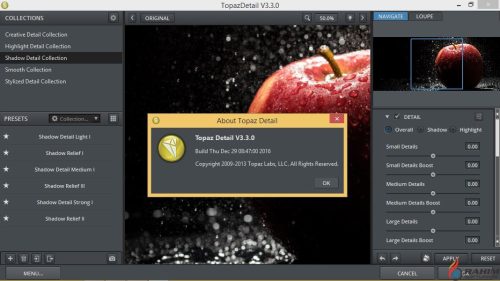

your original photo), and the Output (i.e. On the left is your original image and on the right is the preview of your converted image.Īs with all Topaz software, the interface shows file details at the top left of your Input (i.e. Within a matter of seconds, your image will load and the preview will generate – giving a side-by-side comparison of your before and after images – just like with the screenshot below.
#Topaz dejpeg latest software#
From here you can choose either a single image or multiple images, as the software thankfully supports batch processing. In the centre of the screen is an Open icon – clicking on this opens your upload folder. Further to this, the Topaz site features support videos, tutorials and also a great user forum. When launching the software for the first time, it will present you with a simple three slide user guide.
#Topaz dejpeg latest how to#
It only took a few moments for me to follow a set of tutorial steps, to understand how to operate JPEG to RAW AI. The interface is incredibly simple to understand and use. The Utility Bundle is frequently on discount – you can check here. Topaz Labs offer a whole range of photo editing tools which you can purchase separately, or take advantage of a big saving with the Utility bundle, which includes JPEGtoRAW AI, DeNoise AI, Gigapixel AI (read Gigapixel AI review)and Sharpen AI. Regardless of this, it’s still useful – you’ll see why below. It’s important to mention again that the file produced by this software is a DNG (or a TIF, or TIFF), which is slightly different to a RAW file that comes out of your camera.Ī DNG is Adobe’s proprietary image standard that was created to store image data in a generic format, unlike RAW files that are specific to camera types.Īs such, it’s not as ‘editable’ as a RAW would be – it’s more like the ‘next best solution’ to a JPEG. With Topaz JPEG to RAW AI, details that are minimised by the camera processor can be recovered during the editing process, without any detriment to the image quality.
The more you try to edit a JPEG image, the worse the distortion will be. These are caused by trying to alter the existing data or information more than that data can be pushed. With the larger and more detailed colour space, you can effectively control saturation and vibrance without distorting the image.Īnother pitfall of trying to edit JPEG images is that it can produce ‘compression artifacts’. With this software, it’s so easy to expand the sRGB colour space up to ProPhoto RGB, making the converted file highly manageable. Usually, JPEG images are shot in the sRGB colour space making them difficult to edit without impacting colour patterns and saturation. It works to enhance the range of colour (colour space) available in your images. Using Topaz Labs JPEG to RAW AI, it’s amazing to see an unusable JPEG image transform into a workable and recoverable RAW file. (I found that I could use its AI function to predict and recover lost elements in my JPEG photos, even in incredibly dark areas of my photos.)Īs a result, you can be quite heavy-handed in how you use your editing software to push and pull contrast, shadows and highlights. Using this software goes a long way to recovering lost shadows and highlights. JPEG images – either shot directly as JPEG or converted to JPEG using software – lose a great amount of dynamic range. Most importantly, JPEG to RAW AI is effective at erasing compression artifacts from JPEG images and restoring colour detail. It literally increases the size of the image file as a result – in most cases, it doubles the amount of data! The tool uses the AI knowledge that’s been fed into it, to build upon the existing data in the file. (The final file format is actually a 16 bit TIFF or DNG file.) JPEG to RAW AI is a downloadable image editor that uses machine learning to convert JPEG images to high-quality RAW files for easier editing.


 0 kommentar(er)
0 kommentar(er)
